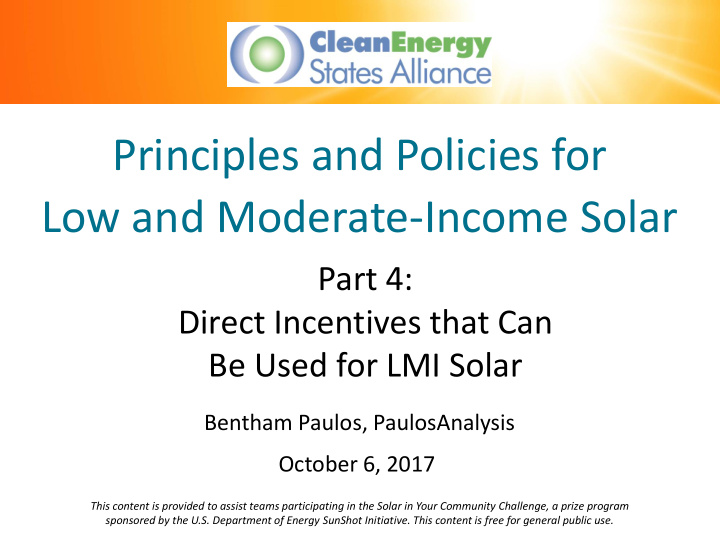



Principles and Policies for Low and Moderate-Income Solar Part 4: Direct Incentives that Can Be Used for LMI Solar Bentham Paulos, PaulosAnalysis October 6, 2017 This content is provided to assist teams participating in the Solar in Your Community Challenge, a prize program sponsored by the U.S. Department of Energy SunShot Initiative. This content is free for general public use.
Learning Objectives • To understand what types of direct incentives are available for distributed solar. • To understand how these incentives do and don’t work for LMI customers.
Net metering • Still common for residential customers, but some states are replacing, reconsidering, or redesigning critical details • Main source of value for customer • Even more valuable if combined with time-of-use rates, depending on times • “Virtual” net metering is key for community solar
Net metering DC 38 States + DC, AS, USVI, & PR have mandatory Net Metering rules U.S. Territories: KEY AS PR State-developed mandatory rules for certain utilities (38 states + DC+ 3 territories) VI GU No statewide mandatory rules, but some utilities allow net metering (2 states) Statewide distributed generation compensation rules other than net metering (7 states + 1 territory) Source: DSIREusa.org
Rebates and tax credits • Federal credit of 30% phases out by 2023 Tax credit phase-out schedule • Requires sufficient tax 35% appetite over two years 30% 25% • State tax credits and rebates 20% 15% vary, but also going down 10% and out 5% 0% • Some extra incentives for 2017 2018 2019 2020 2021 2022 2023 low-income (CA, NY, IL)
Solar renewable energy credits (SRECs) • RECs are used to track RE in compliance and voluntary markets • Solar RECs are traded in DC, MA, MD, NJ, OH and PA • Prices vary by market demand: Currently range from 0.35 cents to 42.7 cents per kWh! • Very valuable in DC, MA and NJ. No value in MD, OH, and PA • Critical to low-income solar in some places Sources: www.srectrade.com and NREL.gov
Value of solar tariff (VOST) • Most common approach globally: feed-in tariff • Replaces net metering: customer sells all solar power at tariff rate and buys all power at retail rate • Based on the stack of values solar delivers, not on retail or wholesale prices • Minnesota and Austin, TX • NY location-based tariff under development
3rd party contracts (PPAs) • A solution for low-income homeowner who has: • Not enough tax appetite • Not enough money down • Good credit • High electric bill and rates • But: • High costs of finance • Prices typically escalate • Not legal everywhere • Not for renters
3rd party contracts (PPAs) NV: With system size limitations CO: With system size limitations VA : Limited capacity DC AZ: Limited to certain sectors LA, MS, SC : Solar leases explicitly allowed TX: With system size limitations U.S. Territories PR Guam USVI NMI At Least 26 States Apparently disallowed by state or otherwise restricted by legal barriers + Washington DC and Puerto Rico Authorize or Allow 3 rd Party Authorized by state or otherwise currently in use, at least in certain jurisdictions Power Purchase Agreements for Status unclear or unknown Solar PV Source: DSIREusa.org
Contact Information Bentham Paulos Principal, PaulosAnalysis ben@paulosanalysis.com www.PaulosAnalysis.com
Thank you for attending our webinar Questions? Contact: Diana Chace Program Associate, CESA diana@cleanegroup.org Visit CESA’s Solar In Your Community Challenge webpage for more info and resources: www.cesa.org/projects/sustainable-solar/solar-in-your-community-challenge-webinar-series Find us online: www.cesa.org facebook.com/cleanenergystates @CESA_news on Twitter
About This Webinar Series This webinar series is divided into two four-part webinars. Principles and Policies for Low and Principles and Policies for Low and Moderate Income Solar, Part 1 Moderate-Income Solar, Part 2 Friday, October 6, 2017 Friday, November 17, 2017 1. Opportunities and Challenges 1. Presenting solar information to LMI 2. Case Studies consumers 3. Financing Options 2. Engaging LMI communities 4. Direct Incentives 3. Solar+storage for LMI communities 4. Community solar for LMI customers Webinar recordings and registration forms are available on CESA’s website at: www.cesa.org/projects/sustainable-solar/solar-in-your-community-challenge-webinar-series
Principles and Policies for Low and Moderate-Income Solar, Part 2 Friday, November 17, 12-2pm ET Topics to be covered: • Presenting solar information to LMI consumers • Engaging LMI communities • Solar+storage for LMI communities • Community solar for LMI customers Sign up at: http://bit.ly/CESA-Webinar-11-17 Virtual Office Hours The instructors will be available for one-on-one consultations with Challenge participants after the webinars, through virtual office hours . To schedule a consultation, contact Diana Chace at diana@cleanegroup.org
Recommend
More recommend